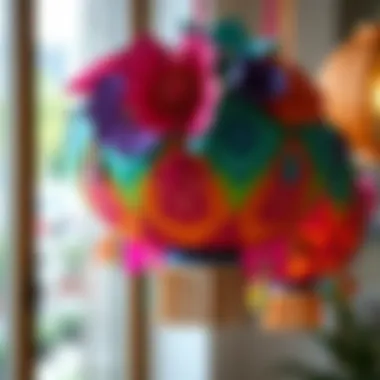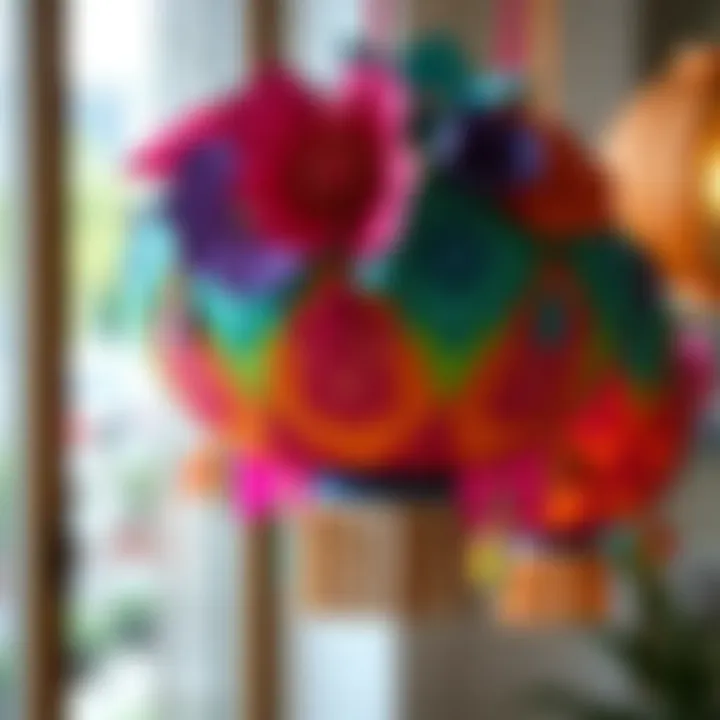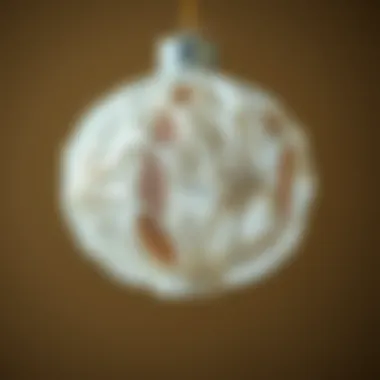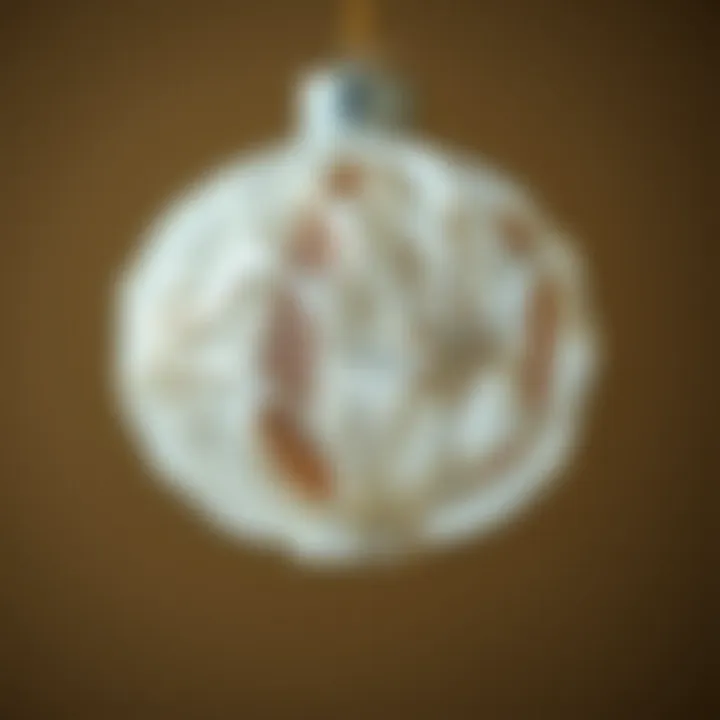Exploring the Art and Science of Paper Hanging Decorations


Intro
When it comes to transforming a space, few elements are as elegant yet simple as paper hanging decorations. These artistic creations not only beautify but also infuse character into rooms, making them more inviting. From ancient cultural practices to contemporary design trends, paper decorations have carved a remarkable niche in the realm of interior aesthetics. The journey begins with their history, touches upon their stylistic versatility, and delivers practical tips on their implementation, catering to both seasoned decorators and eager novices.
In this exploration, we will dive into the myriad possibilities that paper hanging decorations offer. Whether you’re a homeowner looking to spruce up your living space or a professional stylist seeking to incorporate unique design elements, this guide will present essential insights and actionable advice on how to master the art of paper decoration.
As we continue to unpack this topic, it’s vital to appreciate how these decorations reflect personal style and invite creativity into any environment. The interaction between form and function in paper art demonstrates that simplicity can yield profound impacts. By the end of this piece, you’ll be well-positioned to elevate your spaces with striking paper designs that resonate with beauty and purpose.
Understanding Paper Hanging Decorations
Exploring paper hanging decorations provides insight into a unique intersection of creativity and functionality in interior design. These decorations can transform any space, from mundane to mesmerizing, by adding layers of texture and color. People often underestimate the impact that simple paper elements can have when they are strategically placed or thoughtfully designed. When one speaks of paper hanging decorations, it is not only about aesthetics; it opens conversations on cultural significance, craftsmanship, and environmental considerations.
Definition and Scope
Paper hanging decorations refer to a diverse array of ornamental items crafted from paper and suspended in various orientations. These include streamers, garlands, origami, and even detailed paper sculptures that are commonly used for events, celebrations, or simply to beautify everyday spaces. The scope of this art form encompasses several techniques, materials, and styles, each bringing out different tactile and visual qualities. They have found their niche in party planning, home décor, and even in corporate environments, making them extremely versatile.
Historical Context
Origins in Art and Culture
The origins of paper hanging decorations can be traced back to various cultures around the globe, where paper was not only a medium for writing but also a canvas for artistic expression. In Japan, for instance, the tradition of origami serves as an intricate way to create delicate paper structures that were often used for ceremonial occasions. The practice of folding paper has evolved over centuries, illustrating the cultural significance paper holds in artistry. This enriched history underscores why such decorations have garnered admiration in the realm of décor.
Unique characteristics, such as the ability to easily manipulate paper to create stunning visuals, make it a popular choice for artists and decorators alike. Furthermore, its accessibility means that anyone can dive into this craft without substantial investment in materials.
Evolution Over Time
As we look back through history, the evolution of paper hanging decorations mirrors changes in technological advancements and cultural trends. From simple handmade elements to intricate designs aided by digital manufacturing processes, the craft has become more refined over time. The introduction of vibrant colors, various textures, and innovative ideas has significantly boosted its popularity in modern design.
One of the unique features modern paper decorations brings is the range of eco-friendly materials that have emerged due to a growing awareness about sustainability. This aspect not only appeals to environmentalists but also enhances the aesthetic appeal of paper decorations by providing a myriad of options to consumers. However, tapping into trends often comes with challenges, such as maintaining authenticity while appealing to mass production.
"The beauty of paper hanging decorations lies in their ability to evoke emotions and set the tone of any space."
Types of Paper Hanging Decorations
When we talk about paper hanging decorations, we open a door to a world full of creativity and versatility. These elements do not just serve the purpose of beautifying a space; they often evoke emotions and memories intertwined with specific occasions. Understanding the different types can equip interior designers, homeowners, and decorators with the insights needed to create a captivating environment tailored to their needs.
Streamers and Garlands
Streamers and garlands are the quintessential embellishments often observed at parties and celebrations. Their ease of use and affordability make them popular choices among decorators. Streamers, typically long, thin strips of paper or fabric, can be draped or twisted to add a dynamic flair to any setting.
Garlands, on the other hand, can feature a variety of shapes and designs, from traditional flags to modern geometric patterns. They often act as visual anchors—drawing the eye across a room while adding layers of depth to the decor. Streamers can create movement in your space, giving a feeling of festivity or whimsy, while garlands provide a cohesive narrative, reflecting the theme of an event or occasion.
Paper Fans and Lanterns
Paper fans and lanterns bring charm and a sense of cultural richness into the realm of paper decorations. Originating from various cultures, paper fans can be both decorative and functional, providing a cooling breeze on a hot day or simply enhancing the aesthetic of the area. By varying the size and design, one can create a visually stunning arrangement that draws attention.
Similarly, paper lanterns are not just mere decorations; they can transform the atmosphere of a space, casting enchanting shadows and diffused light. They serve well during gatherings, bringing a magical glow that combines both style and warmth. Each paper lantern can tell a story, making them a great choice for thematic decorations, whether for a wedding or a casual get-together.
Origami and Three-Dimensional Structures
Techniques in Paper Folding
Origami is more than just a craft; it represents a meticulous technique that involves folding paper into intricate designs. Its beauty lies in the simplicity of starting with a single sheet and the complexity that emerges through folding. Each fold has its purpose, and understanding these techniques can significantly enhance one’s paper decoration skills.
Key characteristics of origami include precision and patience. These attributes make it a popular choice among those who enjoy detailed work. Using simple origami techniques like valley folds, mountain folds, or reverse folds, you can create stunning three-dimensional decorations that add depth and texture to any environment. However, the challenge here is that intricate designs may require precision and practice, making it both appealing and daunting to beginners.
Applications in Decoration
The applications of origami in decoration are bound only by one’s imagination. Origami can be employed as table centerpieces, wall art, or even hanging decorations that become a talking point at any gathering. The unique feature of origami lies in its robust nature; once folded, the structures can stand on their own, providing a striking visual.
This method allows for customization, as colors and patterns can be selected based on the occasion, making origami a flexible and beneficial approach for decorators aiming to make their mark. One downside, however, is the time investment—creating intricate origami takes patience, which can be a con for those impromptu projects.
Ultimately, from streamers to origami, each type of decoration brings its own flavor, assisting in weaving an overall design narrative. The key is understanding the significance of each and selecting accordingly to fit the occasion, thus enabling the transformation of any space into an experience.
Materials and Tools for Crafting
Crafting paper hanging decorations is an intricate affair, relying heavily on the choice of materials and tools. The right selection can elevate a simple project into a stunning visual statement. Whether you're a seasoned interior designer or a DIY enthusiast, understanding these essentials is key to achieving your artistic vision.
Paper Types: A Guide
Weight and Texture Considerations


When diving into the world of paper, one cannot overlook the significance of weight and texture. The weight of paper, measured in grams per square meter (gsm), impacts both the durability and the visual appeal. Lighter papers (around 80-120 gsm) are often perfect for intricate designs like origami, where crisp folds are crucial. Conversely, heavier papers (above 200 gsm) lend more strength, ideal for freestanding decorations or pieces that need to withstand handling.
One key characteristic of weight is its influence on how colors appear; heavier papers tend to absorb ink differently, resulting in richer hues. This attribute makes them a popular choice among decorators who aim for vibrant, eye-catching displays. However, heavy paper can be trickier to work with, as it requires sharper tools and more effort to cut. The challenge becomes a balancing act between the desired visual outcome and the practicalities of handling materials.
Color and Pattern Selection
The vibrant world of color and patterns can transform a mere decoration into a captivating piece of art. Color selection holds immense importance; certain combinations evoke different moods and can either harmonize or clash within a space. The right choices can enhance an environment's aesthetic, making it feel more cohesive and inviting. For example, pairing soft pastels can create a calming atmosphere, while bold, contrasting colors can energize a room.
Patterns play an equally crucial role. A unique feature of patterned paper is its ability to define styles, from whimsical florals to sophisticated geometries. However, selecting the wrong print can overwhelm a small area or clash with existing decor. This consideration is vital to maintain balance and harmony. While patterns are visually stimulating, they require careful application to avoid visual chaos in the overall design scheme.
Essential Tools
Cutting Tools
When it comes to crafting, the right tools can make a world of difference. Cutting tools such as precision scissors, craft knives, and paper trimmers are indispensable. Each tool serves a unique purpose; for instance, precision scissors offer the control needed for tight curves and intricate designs, while craft knives provide clean cuts for larger, more straightforward shapes.
A notable advantage of these tools is their ability to enhance the accuracy of your work. A consistent cut can bring your vision to life, ensuring that each element aligns perfectly. However, one must exercise caution, as improper use can lead to injuries or jagged cuts. Investing in quality tools can prevent frustration and ensure that the resulting pieces are polished and professional.
Adhesives and Fasteners
Adhesives and fasteners are the unsung heroes of paper decoration. Using the right adhesive—for example, glue sticks, double-sided tape, or liquid glue—can make a project far more straightforward. Each type of adhesive has its unique characteristic; for example, glue sticks are perfect for quick fixes and lightweight materials, while double-sided tape provides a cleaner finish without the mess.
Fasteners offer a different advantage. They can provide temporary or permanent solutions, depending on the project's needs. Paper clips or mini clothespins can create beautiful displays for seasonal decorations, allowing easy modifications. The trade-off, however, is that not all fasteners are aesthetically pleasing; thus, choosing the right type based on both function and form is crucial for a successful outcome.
"Selecting the right materials and tools is not just about utility; it’s about crafting a piece that resonates with your aesthetic vision."
Design Principles in Paper Decoration
In the intricate realm of paper hanging decorations, design principles are not merely guidelines but rather the backbone of effective artistry. Understanding these principles can drastically elevate dull spaces into visually engaging areas that speak volumes about the tastes and intentions of the decorator. Study each component, from color selection to placement, as they come together to create a harmonious environment that captivates the observer.
Color Theory and Harmony
Color is perhaps the most immediate element that influences perception. Each hue comes with its own psychological weight, evoking emotions and setting moods. For instance, warm tones like reds and yellows can energize a room, making it feel lively and inviting. In contrast, cool colors like blues and greens tend us to calmness.
When crafting paper decorations, achieving color harmony is essential. This doesn’t mean every shade has to match perfectly. Instead, you want to find a balance where colors complement instead of clash. Here are a few methods to consider:
- Analogous Colors: Choosing colors next to each other on the color wheel, such as blue and green, creates a soothing effect.
- Complementary Colors: Pairing opposite colors, like pink and green, adds dynamic contrast to your decoration.
Consider how each shade interacts with lighting in the space. Paper decorations might look vibrant in daylight but seem muted under artificial lighting, so test your choices beforehand.
Balance and Proportion
Balance and proportion are about ensuring that no element overpowers the other, creating a sense of equilibrium in your decoration scheme. Think of balance in terms of visual weight; heavy elements might include a large ornate paper lantern, while lighter elements might be delicate streamers. If you hang something voluminous on one side of a room, balance it with other pieces across the space.
Using proportion effectively means considering size relationships between items. A massive garland can look striking, but if the other decorations are too small, the visual impact could fall flat. Group decorations in a way that reflects your desired look: a large piece surrounded by smaller ones in a triangular formation can both captivate the eye while maintaining order. Here’s how to keep balance in mind:
- Symmetrical Balance: Use similar shapes and colors on both sides of a central line.
- Asymmetrical Balance: Create balance with different items that have similar visual weight.
- Radial Balance: Arrange elements in a circular pattern. This works well with decorations like paper fans.
Creating a Focal Point
Every good design tells a story, and the focal point is where that narrative begins. It’s the specific area you want viewers to notice first, drawing their eyes naturally. When arranging paper decorations, think about how to direct attention towards a particular aspect, whether it be a beautifully crafted origami centerpiece or an eye-catching paper flower installation.
To establish a focal point in your decoration, consider these strategies:
- Isolation: Placing a standout piece alone can make it the star of the show.
- Contrast: Using brighter colors or intricate designs against a more neutral background can help your focal point pop.
- Size: Larger decorations inherently attract attention, so they can be quite useful in determining the focal piece.
To wrap up, remember that every choice you make in color, balance, and focal points plays a role in the overall effectiveness of your paper decoration. Design principles are not rules to follow strictly but rather helpful guidelines to navigate your creative process. This flexibility allows for innovation while still aiming for harmony in your designs.
"A well-composed paper decoration doesn’t just hang—it dances within its space."
By truly understanding these design principles, you can elevate your creations from mere paper to stunning art that resonates with viewers.
Installation Techniques
The installation techniques you choose are critical to the success of your paper hanging decorations. Getting this part right helps in achieving a polished look, enhances the visual appeal, and ensures the longevity of your decorations. Whether you’re gearing up for a significant event or simply looking to liven up your space, the installation process is worth careful consideration to avoid unnecessary mishaps.
Choosing the Right Location
Location can truly make or break the overall impact of paper decorations. Selecting a space that complements both the aesthetic of the decorations and the purpose of the event is essential. High-traffic areas like living rooms or halls can benefit from bold, vibrant designs. Conversely, intimate settings may call for softer colors and more subtle arrangements.
When scouting for the right spot, keep in mind the height and size of the space. Overhead installations can draw the eye upward, making smaller areas feel more spacious. Ensure the decorations are easily visible and not obstructed by furniture or other decor elements. A practical tip is to consider the lighting; natural light or focused spotlights can enhance the colors and details of paper art, bringing everything to life.


Mounting and Display Options
Picking the appropriate mounting and display options transforms your paper decorations from mere designs into focal points. Here are two of the most commonly used methods:
Using Hooks and Clips
Hooks and clips are a favored choice for many decorators, providing both convenience and versatility. When applying these tools, one of their chief characteristics is how easily they can be repositioned. This quality makes them ideal for temporary displays, such as event-specific decorations, where adjustments might be necessary.
Another key benefit is that they come in various sizes, accommodating different weights and types of paper decorations. From lightweight streamers to denser paper lanterns, hooks and clips can support a range of items without compromising their integrity.
Despite the advantages, there are pitfalls to be aware of. For instance, improperly placed hooks could mar walls or ceilings, and clips might not hold heavier designs securely, leading to potential collapses. Therefore, assessing the weight of your decorations before choosing this method is critical.
Adhesive Solutions
Adhesive solutions present another viable option for securing paper decorations. The beauty of adhesives lies in their simplicity. There are various types available, including double-sided tape, glue dots, or removable wall adhesives. Each brings its own set of strengths to the table.
One defining characteristic of adhesive solutions is their unobtrusiveness. Unlike clips or hooks, they can provide a clean, seamless look, which is especially desirable for minimalistic themes. Furthermore, they allow for a greater variety of surfaces, including walls and ceilings, thereby broadening your design possibilities.
However, choosing adhesive solutions is not without its challenges. Some adhesive types may leave residue when removed, while others may not hold well under certain conditions, such as high humidity. Testing your adhesive choice on a small area beforehand is recommended to avoid unpleasnat surprises.
In summary, the choice between hooks, clips, and adhesives hinges upon the specifics of your project. Considering factors like the decoration's weight, the desired aesthetics, and the environment will ultimately guide your decision, ensuring that your paper hanging decorations not only look spectacular but also stand the test of time.
Practical Applications in Interior Design
When discussing paper hanging decorations, it's hard to overlook their immense significance in modern-day interior design. These versatile adornments extend beyond mere embellishments; they provide a unique interplay of aesthetics, functionality, and personalization within different settings. From grand event celebrations to the cozy corners of our homes, the potential for transformation is astounding. By incorporating paper decorations, one can easily enhance the ambiance and create atmospheres that reflect style and emotion.
Enhancing Event Spaces
Event spaces, whether filled with formal gatherings or casual reunions, thrive on visual stimulation and thematic expression. Paper hanging decorations serve as highly effective tools in achieving these goals. They can effectively change the mood of a venue within minutes. A few clusters of vibrant paper lanterns can breathe excitement into a birthday party or gala, while soft, muted tones can add an air of elegance to weddings.
Moreover, the flexibility in design and color palette allows event planners to tailor decorations closely to event themes.
"The best event design is often one that tells a story through its decorations. Paper hanging elements can narrate that story beautifully."
Additionally, implementing such decorations does not have to break the bank. Utilizing paper is often an economical choice, especially when compared to other materials. The layman can become his own designer with a little creativity and a few crafting tools.
Incorporating into Everyday Decor
Everyday décor benefits from the charm brought by hanging paper decorations, making spaces feel more inviting and dynamic. The eclectic nature of homes and offices can greatly profit from the inclusion of inventive designs.
Home and Office Settings
In home settings, paper decorations can lift the spirit of a room, effecting a cheerful, vibrant energy that uplifts daily living. Be it the family room adorned with swirling paper streamers or the kitchen adorned with playful paper accents, these elements offer an affordable way to express individuality.
Offices, too, can utilize these decorations to foster a more engaging work environment. With thoughtful placement and design, paper hanging decorations can enhance creativity among employees, reduce stress levels, and even serve as conversation starters during meetings or breaks.
Furthermore, one unique advantage is their ease of customization. Whether catering to brand colors in an office space or personal tastes in a home, these decorations allow for spontaneous changes and seasonal updates.
Seasonal Decorations
Seasonal decorations provide another layer to the beauty of paper hangings, capturing the essence of changing times throughout the year. For instance, during holidays like Christmas, paper snowflakes can elegantly hang from ceilings, or paper pumpkins can brighten a fall-themed gathering.
This adaptability to the changing seasons is a notable feature that keeps interiors lively and relevant. The charm of celebrations is enhanced by these additions, turning any space into a festive haven.
On practical terms, using paper for such decorations again proves favorable. They can easily be stored and reused year after year, making them a sustainable option. Plus, there's always the fun of crafting them with family or friends, adding a personal touch that mass-produced items can lack.
Innovative Trends in Paper Decoration
The world of paper hanging decorations is continuously evolving, influenced by changes in aesthetic preferences, environmental concerns, and technological advancements. This section dives into some of the most noteworthy trends that demonstrate how creativity can merge with sustainability and innovation, enriching the landscape of interior and exterior design.
Eco-Friendly Materials
With a growing awareness of environmental issues, the use of eco-friendly materials in paper decorations has surged in popularity. Sustainable papers such as recycled cardstock, organic cotton paper, and tree-free varieties made from bamboo or hemp have emerged. The benefits of using these materials are twofold. Firstly, they lessen the ecological impact by reducing waste and conserving resources. Secondly, they often bring unique textures and colors that synthetic materials lack, adding a layer of authenticity to decorative pieces.
Incorporating natural dyes further elevates eco-friendly decorations. These dyes not only minimize chemical exposure but also offer a vibrant spectrum of hues derived from plants and minerals that can be stunningly rich. When exploring eco-friendly materials, consider searching for suppliers who are committed to sustainable practices. By sourcing materials ethically, you're not just beautifying a space but also contributing positively to the environment.
Fusion with Technology
As technology evolves, so too does the realm of paper decoration. The advent of digital tools has transformed traditional methods, allowing for innovation that's both engaging and visually striking.
Digital Designs and Printing


Digital designs and printing stand out as a pivotal advancement in the art of paper decoration. Utilizing computer software, one can create intricate, custom designs that can be printed on demand. This specific aspect of digital designing allows decorators to tailor decorations according to personal preferences or themes for events—be it a wedding, birthday party, or corporate gathering.
The key characteristic of this trend is its flexibility; designs can be modified at a moment’s notice. With tools like Adobe Illustrator or free online platforms, anyone can produce professional looking decor without needing extensive training. Digital printing also offers the advantage of high-quality resolution and vibrant colors, making decorations not just beautiful, but also impactful. However, designers should be mindful of costs; sometimes, high-resolution materials and specialized printers can be pricier than their traditional counterparts.
Interactive Elements
An exciting twist in paper decoration is the inclusion of interactive elements. This trend encourages engagement from viewers, turning decor into a participatory experience. Incorporating features like QR codes that lead to videos or apps related to the decoration’s theme puts a modern spin on traditional designs.
The key characteristic of interactive paper decor is its ability to bridge the gap between static beauty and lively engagement. For interior designers, this is a beneficial choice, as it draws attention and prompts conversations, enhancing the overall decor experience. For example, an art gallery might include interactive decoration that lets visitors learn about the artwork on display through their smartphones.
"Innovative paper decoration methods combine classic techniques with modern technology to transform how spaces are perceived."
Nonetheless, the downside might be the complexity involved in creating these interactive features. Time and resources must be allocated carefully to ensure the final product is seamless and enjoyable for audiences.
In summary, the embrace of eco-friendly materials and the fusion with technology are two impactful trends shaping the future of paper hanging decorations. They cater not only to aesthetic desires but also to a broader consciousness about sustainability and interaction in design, making them essential elements in contemporary decor.
By staying ahead of these trends, interior designers, homeowners, and decorators can ensure their spaces are not just visually appealing but also aligned with modern values and technological advancements.
Care and Maintenance
The lifespan and visual impact of paper hanging decorations hinge significantly on how well they are cared for and maintained. Neglecting care can lead to wear and tear that diminishes the overall aesthetic and integrity of these decorations. Understanding this aspect is crucial for anyone looking to invest time and resources into paper art. Aside from preserving the beauty of these creations, proper maintenance also plays a part in ensuring they remain safe and allergy-free in indoor environments. Here are some key cleaning and storage tips to consider.
Cleaning Techniques
When it comes to cleaning paper decorations, gentle is the name of the game. Using abrasive cleaners or scrubbers can do more harm than good. Here are some steps you can follow to clean various types of paper decorations:
- Dust Regularly: Use a soft, dry cloth or a feather duster to gently remove dust from decorative pieces. This should be done regularly, as dust can accumulate quickly, especially in high-traffic areas.
- Spot Clean: For minor stains, a damp cloth can be effective. It’s important to ensure that the paper is not soaked, as this can lead to warping or tearing. A gentle dab is usually enough.
- Avoid Cleaning Solutions: Unless specified by the manufacturer, avoid using chemical cleaning products. They can cause discoloration or deterioration of the paper.
Keeping paper decorations clean not only enhances their appearance but also helps in maintaining an allergy-friendly environment by minimizing dust and allergens.
- Use Compressed Air: For intricate designs like origami or layered decorations, using compressed air can help dislodge dirt without touching the surface. This method allows you to clean hard-to-reach areas while preserving delicate structures.
Storage Recommendations
Proper storage is just as important as cleaning. If you plan to keep your decorations for future use, following these tips can help maintain their quality:
- Choose the Right Environment: Store paper items in a cool, dry place. Humidity can cause paper to warp or encourage mold growth.
- Use Acid-Free Containers: If you're placing the decorations in boxes or folders, opt for acid-free materials to prevent yellowing or weakening of the paper over time.
- Avoid Direct Sunlight: Prolonged exposure to sunlight can fade paper colors. Keep decorations in a dark or shaded area to prolong their vibrancy.
- Support Structures: For 3D paper decorations, ensure they are stored in a way that prevents crushing. Use tissue paper or bubble wrap for additional support when stacking.
Understanding the nuances of care and maintenance not only helps to keep your paper hanging decorations looking fresh but also reinforces their place in your home or event space as charming and beloved features. Taking a few simple steps can make a world of difference in preserving their allure and lifeline.
Potential Challenges
When diving into the world of paper hanging decorations, understanding the potential challenges can set the stage for a successful decorating experience. Every ins and outs need to be thought through carefully since the scope of this craft blends creativity with technical skill. Recognizing these pitfalls will not only enhance your outcomes but also transform the decorating process into a smoother venture.
A key consideration is the varying dynamics of environments. Each space poses its unique specifications, such as dimensions, lighting, and existing decor themes. It can be tempting to assume that what looks splendid in one area will have the same impact elsewhere, but this just ain't the case. Every corner has a story to tell, and adjusting to those narratives is crucial to creating harmony between your paper art and the surroundings.
Common Mistakes to Avoid
- Underestimating Paper Weight: Many decorators select paper based on looks alone without considering the weight. Lighter paper might flutter charmingly but can also be a challenge in windy areas or high ceilings where they need a proper adhesive. It's like expecting a breezy summer day in the middle of winter.
- Ignoring Color Integration: Choosing colors that clash rather than complement is another common error. Tones should relate to each other and the existing palette. Not every color can play nicely together—be cautious when mixing hues that can overstimulate eyes, leaving a sour taste.
- Neglecting Scale and Proportion: Another popular misstep lies in not properly measuring the scale of decorations. A massive streamer sprawled across a small room can feel overwhelming, while a delicate piece in a cavernous space can disappear, losing its intended effect.
Avoiding these mistakes can save time and effort down the line. Ensuring that your choices align will provide a more cohesive look and overall decor experience.
Adapting to Various Spaces
Adapting paper decorations to fit different spaces requires a unique touch. What works well in a cozy home may fall flat in a grand hallway. Here are a few critical approaches to adjusting your design:
- Assess the Environment: Observe both the size and lighting of the space. A well-lit area allows for brighter colors, while dim corners may need soft pastels or metallics to catch the light, creating the right mood.
- Utilize Vertical Space: In smaller rooms, consider hanging paper vertically to draw the eye upward, giving a sense of lift. This trick navigates the limitations of width and helps maximize the use of a confined area.
- Consider Functionality: In areas where movement is frequent, such as hallways or entries, it may be wise to choose decorations that aren't overly intricate or imposing. Screaming for attention can create clunkiness where fluidity is needed.
Adapting paper decorations is about making choices that respect and enhance the essence of the space. Building a successful relationship between decoration and environment leads to charm and a sense of delightful balance.
Closure
The world of paper hanging decorations is not just about aesthetics; it embodies a blend of history, culture, and innovation. The conclusion of this article ties together the various threads weaved throughout our exploration, spotlighting the tremendous versatility and potential that these decorations hold. Understanding the significance of paper hanging decorations enables various professionals such as interior designers, homeowners, and decorators to harness their beauty to shape spaces effectively.
Recap of Key Points
To recap, we examined several crucial elements concerning paper hanging decorations:
- Historical Context: The rich origins and evolution of paper art demonstrate its cultural significance over the years, setting a solid foundation for contemporary practices.
- Types of Decorations: From streamers and garlands to intricate origami structures, the diversity in styles offers endless opportunities for creativity.
- Materials and Tools: A clear understanding of paper types and necessary tools helps in achieving the desired effect and longevity in decorations.
- Design Principles: Color theory, balance, and focal points enhance the overall impact of decorations, ensuring they resonate with the intended audience or purpose.
- Installation Techniques: Correct mounting options ensure the durability and aesthetic appeal of decorations, crucial for event spaces or permanent installments.
- Care and Maintenance: Keeping decorations clean and well-stored preserves their look and functionality over time.
- Challenges: We discussed common pitfalls and solutions, aiding decorators to navigate them successfully.
"The artistry of paper hanging decorations is not simply a craft; it’s a form of expression that transforms environments and experiences."
Future Directions in Paper Decoration
The future of paper hanging decorations looks promising, with creativity and sustainability leading the charge. Here are several avenues worth exploring:
- Sustainability Focus: As more consumers become eco-conscious, the demand for eco-friendly materials, like recycled papers and organic inks, will continue to rise. Integrating sustainable practices in crafting not only benefits the environment but can also impress clients looking for more mindful designs.
- Technological Integration: Advancements in digital printing and design technology will allow for personalized and intricate designs that were once thought to be painstaking. This fusion opens up a world of possibilities for both mass production and unique, one-of-a-kind pieces.
- Interactivity in Design: Future innovations might include interactive elements within paper decorations, such as QR codes that lead to augmented reality experiences or the integration of sensory elements that engage audiences in deeper ways.
- Cultural Inspirations: As globalization continues, there's an opportunity for cultures to intertwine within the realm of paper decoration, leading to innovative designs that celebrate diversity and bring fresh perspectives to classic styles.
In summary, the realms of paper decoration are consistently evolving, and those who embrace change while acknowledging tradition will shape the future of interior design in exciting ways.



